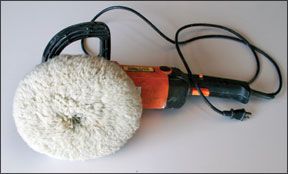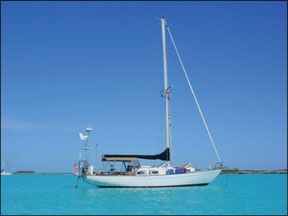I am the happy owner of a 1967 Pearson Invicta II that has served very well as a cruising boat. We purchased her in Long Island, N.Y., in less-than-desirable condition, and now she is back from three years of cruising in the Bahamas and the East Coast, where shoal-draft/centerboard boats are ideal.
I would like to mention the often-overlooked advantage of the low-aspect rig. I speak from the experience of racing for many years and as a guy who wants to keep his mate happy. As a cruising couple, we prefer to keep the sailplan simple, and the combination of a long-footed mainsail and a poled-out 135-percent genoa is a great downwind setup. The telescoping pole is a key element.
We have not needed a spinnaker or cruising chute. The poled-out genoa is easier to maintain in the often sloppy seas and light air of downwind sailing. It is also easier to reduce sail area and keep going when conditions change.
The Bristol, Morgan, and Ericson of CCA era are also good picks, and there are many out cruising with happy owners aboard.
Scott Nicholls,
Saltine, Pearson Invicta II
Port of Minneapolis, Minn.
I live in the Philadelphia area and am looking to buy a 23- to 25-foot sailboat. I have seen some interesting sailboats in Florida and other Southern states. Is transporting one up to Philadelphia safe, and could you recommend any transporters?
Howard Solomon,
Philadelphia, Penn.
A 23- to 25-foot boat is easily and safely transportable. You could do it yourself, if you have a trailer and a vehicle that can handle towing a 3,000-plus-pound boat. We recently came

Photo by Ralph Naranjo
288
across a website that could help you find a reliable transporter: www.uship.com. The site allows you to post the transporting job you need done, then companies bid to get the assignment, and you get to choose the winning bid. Also, customer reviews on the website help you determine which transporter is worth your buck. We’ve not used the site or its services, but we like the reverse auction concept. Another way to get a good deal is to contact boat dealers in your area to see whether they have any shipments destined for the pick-up location of your boat. In some instances, if their trailer is coming back empty anyway, they’re likely to agree to bring back your boat for a good price—and you will know they have the experience to handle the boat with care. At the very least, a local boat dealer will be able to give you the name of a trusted shipping company.
After reading the article on Man-Overboard Alarms in the PS 2009 Gear Buying Guide, I thought I’d share some thoughts I’ve had about MOB situations.
First, it seems obvious to me that an man-overboard’s best chance for rescue is not from SAR networks or nearby vessels but from the vessel from which he has fallen because that vessel is closer than any other potential rescuer.
It also seems obvious to me that the MOB position is of limited value, as the MOB will drift away from it progressively with time. Of far greater value is the MOB’s actual position, which is best reported by a transmitting GPS device worn by the MOB that can be easily monitored and homed-in on. This is also far more useful than an RDF device, as it renders the MOB’s position as a point rather than a range.
David Laing,
Roundeclay, 1974 Seafarer 38C ketch
Punta Gorda, Fla.
Since our last test of electronic MOB alarms and recovery aids (May 2008), there has been significant development in this area. The new GPS-enabled V-100 from Mobilarm (www.mobilarm.com), for example, sends updated position data via VHF DSC frequency, positions that can be tracked on some plotters. Search-and-rescue agencies are also looking at other ways to integrate the automatic identification system technology (which also uses VHF frequencies) and next-
generation navigation satellites so that nearby boats will be sent continuous position data for a person in the water. Despite the increasing role of electronic tracking devices, the seamanship skills discussed in this month’s report remain paramount.

Photo courtesy of Scott Nicholls
288
I am curious about the spray application of the two-part polyurethanes in your topside paint test (November 2009). In the photograph showing spray application (photo above), it does not appear that the applicator is wearing an air-line mask. What sort of filter is used? What are your recommendations in this regard?
Mike Wyatt,
Ohana, Pearson 365 ketch
Bainbridge, Wash.
When it comes to spray work, a separate air supply is always the best bet, as long as the compressor is designed to deliver breathable air, and not placed downwind or too close to the spray work. That said, spraying outdoors (small to medium projects) can be safely done with a tight-fitting filtered respirator, as long as the filters have the proper National Institute for Occupational Safety and Health (NIOSH) rating for the material used, and are new or have been stored according to manufacturers recommendations. You can find lots of information regarding respirators and their usage at the NIOSH website: www.cdc.gov/niosh/npptl/topics/respirators/disp_part/RespSource.html. Our technical editor prefers 3M 6000 masks and uses 6001 Organic Vapor Cartridges. He also uses a light cotton sock balaclava, eye protection, gloves, and a Tyvec suit or other full-coverage clothing. Covering up and replacing mask filter cartridges regularly is part of the paint-handling ritual.
I noticed that you are planning an evaluation of marine heads in the near future. Please address the very practical problem of the shape of the bowl. I have one of the popular Jabsco manual heads. All of the mechanics of it work fine, but there is one significant problem: The small bowl is rotationally symmetrical, so that its deepest part is centered below the middle of the seat. Home toilets have the deepest part of the bowl near the edge of the back rim for an obvious reason.
Hasty Miller,
Skimmer
Palm Bay, Fla.

Photo courtesy of Scott Nicholls
288
Among the heads we plan to test, Thetford Marine’s ComfortMate toilet line (electric and manual options available), which was launched last year, addresses this problem. The ComfortMate (www.thetford.com) has a shape and full-sized seat like the toilets founds in homes. However, it was engineered to fit a marine head, and its manual pump or pushbutton control can be adapted for right- or left-handed installation.
Having been a subscriber to Powerboat Reports until it was sold, I subscribed to your publication—even though I’m not a “rag sailor”—and what a publication it is! You folks do an unbelievable job with your testing, so complete and totally realistic. Most boating publications miss so much of what’s applicable to boat owners.
Robert Weiss,
Summer’s Lease, Harris-Cuttyhunk 28
Oak Bluffs, Mass.
One of the greatest strengths is our informed and critical readership. Our readers (yes, that’s you) as much as our staff deserve any praise that comes our way. More than a few of our longtime readers have since made the switch to power (often reluctantly), and we are proud to continue to serve them.
Regarding your recent article about drug-free seasickness medications (November 2009), I am a U.S. Coast Guard- and U.S. Sailing-licensed instructor who teaches the U.S. Sailing Coastal Passagemaking classes every month, 10 months of the year, in the San Francisco Bay area for Club Nautique. Our classes consist of a 2.5-day passage along the coast (within 23 nautical miles), and I have seen every type of seasickness medication used as our students try to fight motion sickness.
Every one of the students seems to rely on the medicated therapies over non-drug remedies, with Dramamine or the Scopalamine patch being the favorites. But these alone don’t always work.
The biggest problem is with our student navigators, who must either sit at the vessel’s navigation station or assume a position in the companionway. Reading paper charts is what gets most of our students. Trying to read the small print while on a moving vessel is very hard for your internal balancing mechanisms.
I’ve learned a trick to ward off sickness feelings. I never stand or sit facing the beam of the vessel. I always try to stand or sit facing the bow or stern of the boat. That seems to give my inner ears a chance as they only have to deal with one axis. When I ask my students to do this, it seems to work most of the time.
I have to admit the above technique is used with medications like Dramamine or the Scop patch. If the crew is conscious of minimizing the burden on the inner ears and eyes having to fight for balance, they seem to survive.
Capt. Thomas E. Perry,
Polonaise II
San Francisco Bay, Calif.
I am almost sure that in the past two years, you guys reviewed/evaluated orbital polishers, but I can’t locate the article in my copies of the magazine. Can you advise me of the article?
Ray Norton,
Via e-mail
Our dirt cheap Chicago Electric variable speed polisher from Harbor Freight (June 2008) rattles but still works fine after three seasons. You can find one online at www.harborfreight.com, item nos. 92623-4VGA ($35) and 66615-1VGA ($60).
For a much better tool, check out the variable-speed polishers from Milwaukee Tools (www.milwaukeetool.com), Makita USA (www.makita.com), or DeWalt (www.dewalt.com), in that approximate order. Also, the lightweight Fein (www.fein.com) is highly prized by pros, but it’s expensive.
Shurhold recently introduced a new dual-action polisher, which we will be reviewing soon. According to the company, the $150 lightweight, random-orbital polisher is designed specifically for DIY boaters.
The Harbor Freight polisher is made in China, and you get what you pay for. Be sure to blow them out with air after heavy use, or else the brushes will go bad fairly quickly.
Admittedly, we are much happier using our neighbor’s Dewalt, which is much smoother and quieter.
We haven’t done a head-to-head of these in a while, but we can suggest Jamestown Distributors as a good source of information on the preferred buffing pads. You can often buy the pads cheaper at a local auto-finishing store. When it comes to polishing gelcoat, the 10-inch power-waxers you’ll find at Walmart aren’t much help.

Photo courtesy of Scott Nicholls
288

Photo by Ralph Naranjo
288
A photo on page 29 of the November 2009 issue was incorrectly labeled. The photo actually is of the solar panels atop the Tacktick Race Master.
In our discussion of prepping a hull for painting (“Wax On, Paint Off?” November 2009), PS neglected to mention that Poliglow recommends using its remover, Poli Strip, prior to painting a hull that had been previously treated with Poliglow. According to the maker, wet-sanding alone may not be adequate.

































